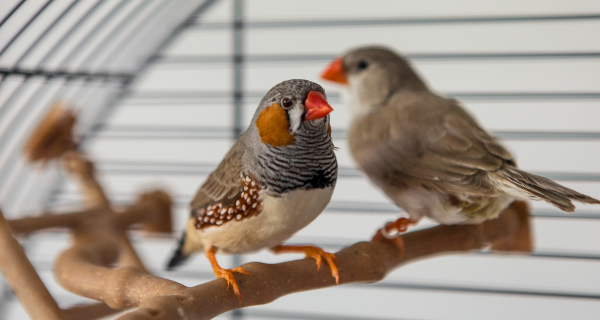
Information supplied by Dr Danny Brown BVSc(Hons) BSc(Hons) MaCVSc (Avian Health) for The Pet Directory
It seems odd that the primary life supporting component of a finches existence is often the part that aviculturists will try to cut corners with. Without a suitable diet, birds will not perform as we expect them to. This is as relevant with undernutrition as it is with overnutrition. What is about to be presented is a critical (and often somewhat cynical) review of some components of finch nutrition that seem to always cause some confusion.

The short answer to this is that nobody really knows. Critical examination of the wild diets of finches is limited to a few species and often at selected times of the year. For the majority of finches we are left with the blind hope that “finches are all the same” , a fact that we know is not true. How then do we design a diet for a finch collection and cater for everybody. ??. How do we do this without the need to spend all day preparing this “wild” diet??.
Firstly, lets look at the basic requirements of the “average” finch and then look at where aviculturists often lose their way.
Carbohydrates are present in adequate quantities in most foods that we offer to finches and therefore are not a limiting factor in the development of finch diets.
Proteins are required for maintenance and growth in all birds. Most literature suggests a maintenance protein level of 8-10% and a growth requirement of 18-25%. It is obvious from this that a maintenance diet is therefore not going to be suitable for raising young which require higher protein levels. Excessive protein levels may be well tolerated by some birds but potentially can cause problems in birds with underlying kidney disease.
Fats are usually required at a level of 8-15% but many seed diets will provide fats at greater than 40%. Rarely would a deficiency of fats occur but excessive fat intake is common. Fats are primarily needed to supply energy and fat soluble vitamins. Seed is considered the staple diet of many finch species. Seed, however< is realistically a very poor diet in many aspects and may not even meet the basic maintenance requirements of most species. Seed is generally deficient in protein , unbalanced with regards to essential amino acids (particularly lysine, methionine, glycine and proline), marginal or deficient in calcium, lacks precursors for the metabolism of vitamin A, variably unbalanced with regards to phosphorous, sodium, manganese, zinc, iron, iodine, selenium and B vitamins and generally excessive with regards to fats.
Birds are not generally capable of selecting there own balanced diets, and like humans, will often selectively consume inappropriate components in excess. This is particularly true of high fat seeds which are often selectively and excessively consumed as a means of attempting to consume excessive energy to compensate for missing proteins and energy in other parts of the diet. High fats seeds are NOT preferred just because they taste better. Providing a seed mix or individual seeds in there own dishes therefore provides no specific benefits as at the end of the day we are simply making it harder or easier for a bird to eat an inappropriate diet.
Specific Misconceptions/Theories in Finch nutrition
Seeds vs crumbles
Recent efforts have been made to convert all aviculturists onto pelleted or crumbled diets as the ultimate alternative to seeds. Whilst I am a very strong supporter of these ideas I am also aware of their limitations. Crumbled based diets are design to provide the exact nutrition needs of the “average” finch and to eliminate those deficiencies and excesses that occur when feeding seed. Crumbled diet are presented in a size and shape that makes them generally palatable and easy to consume. They are more cost effective as there is no waste component (i.e no husks). They are now readily available to most aviculturists. Why then are we not all feeding crumbles.??.
Primarily, most aviculturists are resistant to change and always looking for the cheapest option. Price per kilogram is often more important than quality or actual real benefit to the bird. The initial higher price per kilogram is the first deterrent (but remember there is 60% less waste so the cost really evens out at the end). Tradition plays a large role in resistance to formulated diets. “My father fed nothing but seed and weetbix for 40 years so why do we need to change”??. As time goes by we learn that most of our traditional management techniques can be improved upon and are often responsible for many of the problems that we take for granted. Not all birds will accept crumbles with open arms (or is it wings). Some birds will still step over the crumble dish to get to the seed bowl. Remember that this is mainly ingrained learnt behaviour and the birds are not “intelligently” seeking the better diets, just what they are used to. Other species will consume crumbles and ignore their seed dish.
What is the answer??. To ignore the benefits of crumbles in the face of knowing the deficiencies of seed is in my opinion dietary cruelty. I feel that all aviculturists owe it to their birds to provide a diet that offers to be more balanced that what they are currently FORCED to eat. A diet comprising at least 50% crumbles is a good start. In some birds, particularly cabinet bred or indoor aviary birds a diet of 80-90% crumbles is more realistic. REMEMBER that this is MAINTENANCE diet only unless a specific “breeder crumble “ is selected. Extra supplements will still need to be fed to breeding birds.
Homemade diets vs commercial preparations
One of the more frustrating aspects of advising diets to aviculturists is the misconception that the quality of the diet is directly proportional to the number of ingredients. “A diet with 60 ingredients must be 10 times better than a diet with 6 ingredients”!!!. WRONG !!!. The more complex diet may be more balanced but may also be unbalanced.
Most breeders are more concerned with how impressive the mix looks than if it is actually better for the birds. It takes a complex computer program to determine the dietary breakdown of a diet with 10 ingredients, yet bird breeders can often miraculously “guarantee” the dietary benefits of their diet based on how “it looks in the dish”. The smaller the number of ingredients of known nutritional value that are provided, the more control you have over that diet. My own preference is to use specific formulated ingredients that can “guarantee” to provide what is on the label. I then mix this with a select few ingredients to provide for texture and additional greens. Do not let somebody tell you your diet is inferior because it has less ingredients.
If using commercial preparations, purchase from a respected source. Open bagged, unlabelled products may as well be talcum powder as you have no proof of nutritional analysis. For many of these products it is unlabelled because it has no nutritional basis for its development. It simply looks good in the bag. If you use these products then have no expectations of quality.
Protein levels
A common target for finch breeders is to “get as much protein into them as possible”. This is not a particularly useful endeavour as we can see above that the actual protein requirements for growth are not that excessive. The commonest problem is that a breeder will maintain a poor overall diet and then expect a protein supplement of 35% or better to make everything OK. There are several flaws in this method. If the bird consume only 10 % of its diet as protein supplement with an otherwise poor 90% diet it will at most only increase the dietary protein by 3-4% as it is diluted down. It is better to feed a good maintenance diet and allow the birds to feed on a good quality, palatable supplement of 25-27% protein mixed with a food that is consumed avidly such that it consists of 50% of the breeding diet (or less if live food is also fed). This can potentially increase the protein levels of the diet by 10-12%. It is important to note that excess protein is not necessarily utilised by the bird and is more likely to be dumped by the bird as protein waste (urates - the white part of the droppings) . In a healthy bird on good nutrition this poses no problem but in an unhealthy bird in may place excessive strain on the kidneys (where protein waste is metabolised). Another problem with extremely high protein supplements (e.g. turkey starter, soybean meal) is that they are often high in fats as protein levels this high can only remain stable in the presence of higher fat levels.
Many of the very high protein supplements are less palatable so actual consumption may be much less than expected.
Soak it, boil it or sprout it ???????
Modifying seeds to increase their nutritional value incites much debate. The preparation of the product may carry with it risks associated with hygiene issues. The preparation may not improve the seed at all. So what are the benefits ??. I believe the major benefits of “Modified seeds” are reduced manipulation time for the parent birds, their function as a supplement carrier and improved nutrition with sprouted seeds. This can be summarised as follows :
- Boiled seed - softer seed, excellent carrier for powdered or liquid supplements, rapid preparation, minimal hygiene risk, possible nutrient leaching/loss as seed is “dead”..
- Soaked seed - softer seed, excellent carrier for powdered or liquid supplements, slower preparation, some hygiene risk, no improvement nutritionally.
- Sprouted seed - softer seed, excellent carrier for powdered or liquid supplements, slowest preparation, some hygiene risk, improved nutrition as plant carbohydrate is converted to plant protein.
Hygiene can be improved dramatically by the use of household bleach at the FIRST step of soaking in soaked or sprouted seed. This gives much better results than rinsing in bleach later. Bleach residues are not an issue as all chlorine is released from the mixture as chlorine gas leaving behind NaCl (Sodium chloride - salt water).
A further improvement is to heat the mix on a nursery heat pad (as per David Whites method 2002 convention) and this will produce sprouted seed in the time previously needed for soaked seed production.
The activity as a carrier is in my opinion the most important and allows the aviculturist to add essential fatty acid supplements (Breeding Aid), vitamins, calcium, trace mineral supplements (Tracemin Soluble) and protein supplements in quantities with an expectation that they will be consumed in total.
Austerity diets
This is perhaps one of the more abused husbandry methods that I have seen. The theory is sound - feed the birds on a lower plane of nutrition during the period that you wish them not to breed and increase the diet quality when you want them to breed. In practicality what happens is the birds are maintained on a plane of malnutrition and are then expected to respond to full breeding condition once nutrition is restored. The danger of this is that these birds are not physically capable of sustaining breeding activity if malnourished in the austerity period.
AN AUSTERITY PERIOD IS NOT A PERIOD OF SEED AND WATER ONLY. THE DIET DURING THIS PERIOD MUST BE COMPLETELY BALANCED BUT OF LOWER PROTEIN THAN THE BREEDING DIET.
Austerity periods aim to mimic the sudden appearance of improved feed and the breeding stimulus that this creates. In reality unless the diet is completely balanced all year round it will provide no benefits over and above what can be achieved by maintaining seasonal breeding pairs together all year round on a stable diet.
If your only aim is to rest breeding birds you will achieve more by separating the sexes or moving the pair to a holding cage although I am yet to see benefits with this approach either. Exceptional breeding birds may “burn out” if not allowed a rest but ultimately if nutrition is suitable this is a more significant influence on their longevity.
My recommendation is that if you wish to rest birds from breeding or maintain them on a lower plane of nutrition out of season then this is where crumbled diets can be utilised to their best as you can provide a complete balanced nutrition at maintenance level with little effort.
Oil seeds
This is a personal bugbear of mine. Tradition tells us that Fringillid finches (canaries, siskins etc.) must be fed on a seed mix containing oil seeds (rape, niger, linseed, crushed sunflower) or they will perish from lack of fats in their diet. This tradition stems from the feeding of these predominantly European birds in temperate European countries. When we bring these species in subtropical or tropical areas in cannot be justified that these birds must continue to be fed these diets. Neither canary seed mixes or extra oil seeds (particularly crushed sunflower) are needed in these parts of Australia. Sure, they love to eat it but it is because of its high energy/high fat content (and the subsequent compensatory feeding as described above) that they gorge it, not because they need it to survive. These feeding practises are akin to the hideous practise of feeding cockatoos on sunflower seed diets. Do yourself a favour and treat these birds as finches, not canaries.
Over Supplementation
Just as there are minimum requirements for certain vitamins and minerals in the diet, there are also maximum safe levels. When using vitamin, mineral, calcium or fatty acid supplements please follow directions carefully. Overdosing is possible particularly with vitamin A. The old habit of using cod liver oil should be discouraged for this reason as it is rarely measured to any calculated dose rate. In addition it may contain high levels of an enzyme called gizzerosine that may predispose to gastric ulcers and high levels of unsaturated fats which deplete vitamin E levels through a chemical transformation called oxidation.
Vitamin A toxicity has been implicated in the deaths of particular coloured mutation forms of gouldian finches (blues) and is suggestive that this colour form may genetically be predisposed to kidney damage from Vitamin A toxicity or have less tolerance to it.
Excessive Calcium supplementation can also be toxic causing growth deformities in young birds and constant high level supplementation may “switch off” calcium uptake mechanisms in adults (which will actually render them more prone to problems like egg binding). Follow directions carefully.

Feeding your food
Live foods are an important part of finch husbandry. Preparing your live foods for feeding can lead to problems.
Maggots have been implicated in several problem scenarios. Prepared properly however they pose no more risk than a birds face when feeding on seed on a natural earth floor. If maggots are provided to the birds in a form where milk soaked substrate is still present then food contamination organisms are likely to be present. The growing substrate should be at a point where maximum digestion has taken place and should resemble dark brown sawdust. NEVER add more moist substrate to this. This will probably cause major arguments but so be it.
Some breeders are concerned about the concept of lactose intolerance associated with breeding maggots using milk powders. If the substrate is fully digested than this should not be an issue. Some people will not breed maggots as they find it hard to justify purchasing large bags of calf milk powder. The simple answer to both of these is to use good old fashioned liquid milk in a low lactose formula (after all, milk powder + water = milk). If you want to increase calcium, use high calcium milk. If you buy 1 litre UHT bottles you can have it on the shelves in the bird room at all times.
Most people breed their maggots in wheat bran. The small danger with this is that bran can at times contain high levels of a chemical called phytates which if ingested can bind calcium in the birds body and make in unuseable. The alternative to this is to use coarse pollard or mill run which contain less phytates and have the added benefit of containing about 10% protein, resulting in the reduction in the amount of milk needed (milk is using as a protein source by the growing maggots).
Phytates are also an issue when meal worms are grown in wheat bran. Pollard or mill run can be used as a substitute here.
Gut loading is a concept that has been embraced by some keepers without full understanding of the concept. Gut loading is the term used to describe the feeding of higher quality (higher protein or higher calcium) diets to the live foods before presentation to the birds so that the bird is eating the insect and it’s better quality gut contents.
This concept was designed as a means of improving the usefulness of poorer quality foods such as meal worms. It has however been abused as a means of “pumping up the protein”. This has several disadvantages. One overlooked problem is that insects are animals too and super high protein diets may actually be toxic to the insects metabolic processes resulting in slower insect growth and live food dying off before being fed. More importantly, the nature of insects to eat what they are given means that foods which may not otherwise be eaten in large volumes by birds may be packaged in each and every insect they eat. A potential example of this is the use of soybean meal as a final growth feed for maggots. This results potentially in young birds being fed maggots with gut fill of 40% protein and potentially high levels of concentrated phyto-oestrogens. Anecdotal evidence suggests that this can lead to almost epidemic low fertility in those birds eating large quantities of “soya-maggots”.The basic rule should be that you should only gut load with foods that you would be happy for the birds to eat of their own accord (and only if they are likely to provide benefits over your regular growing medium).


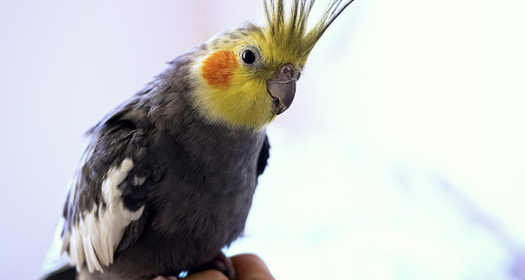
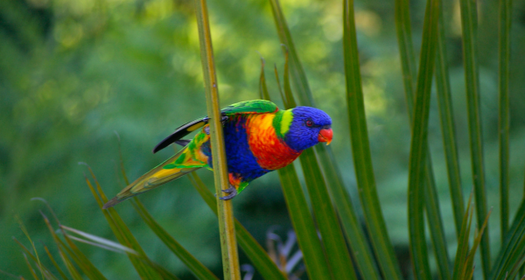
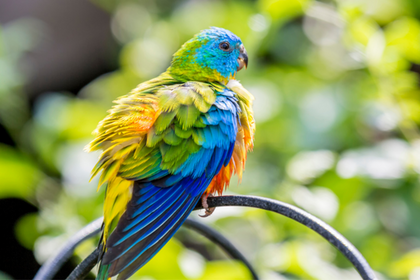
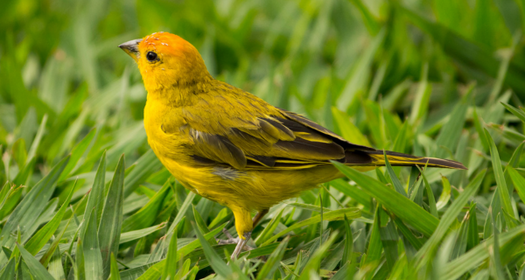
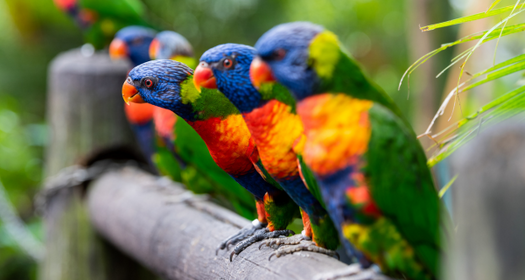




Leave Comment Below